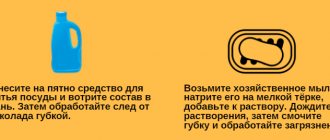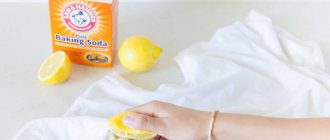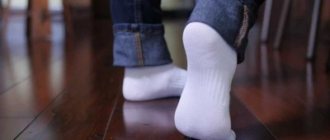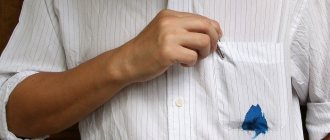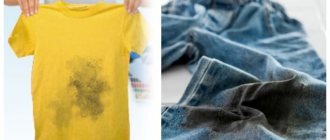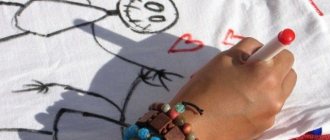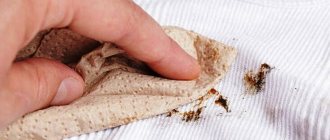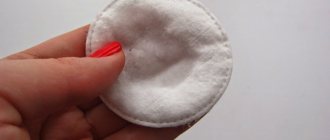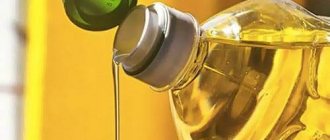Rules for removing paint stains
The axiom of housewives says: the fresher the stain, the easier it will be removed. So what do you need to know to clean your clothes?
- Study the properties of textiles, the type of dye immediately after contamination.
- Not all methods are equally good, some can ruin the thing. Therefore, test your chosen cleaning product on the underside first.
- If the stain remover has warning signs about rapid ignition, a strong smell of gasoline appears, it is better to carry out the manipulation outdoors.
- Cover the surface where the treated item will lie with film.
- To clean, use a cotton swab, this is an excellent option for preventing fabric fibers from shedding.
- Cleaning should occur from the reverse side.
- Constantly change cotton swabs to remove any remaining dye as effectively as possible.
- You can avoid stains on things from removing stains by placing a white napkin under it. The napkin absorbs the remaining liquid.
And two more news, one good, the other not so good: watercolor and gouache can be easily washed off, but oil-based paints will require a lot of effort to remove.
What is watercolor paint made of?
As a rule, manufacturers do not indicate the full composition of the paint on the packaging. But in addition to pigments, the tube also contains other ingredients that perform various functions:
- binding component;
- plasticizer;
- a substance that prevents paint from rolling off;
- antiseptic.
The basis of watercolor is pigment - colored powder. Its smallest particles are not interconnected and also do not connect to the paper. After drying, such a mixture would simply fall off the surface on which it was applied.
The binder holds the pigment particles together and ensures their interaction with the paper. To make watercolors, a water-soluble binder is used, so paint that has dried on the palette can be reused.
watercolor paint
The most common binding component for watercolors is gum arabic. This is a transparent solid resin made from acacia sap. Some manufacturers use cheaper components: dextrin (starch-based), cherry or sloe gum.
To give watercolor paint the desired consistency, plasticizers and humectants are added to it: glycerin, sugar syrup or honey.
A component such as ox bile prevents paint from rolling off and facilitates easy distribution on paper.
To extend the life of watercolors, an antiseptic, phenol, is added to it. It protects the paint from mold.
Expert opinion
Irina. Housewife.
Ask a Question
Watercolors may also contain various dispersants, preservatives and thickeners. Each filler plays its role and benefits the consumer - it gives the paint the necessary properties.
Fresh spots
Removing fresh stains is the least evil; the paint has not yet had time to be absorbed into the textile fibers, they have not yet dried and have not changed their structure. What can you use to remove stains? You can display them using the following means.
- Using gasoline when contaminated is a proven cleaning method. To use gasoline, the fabric must be natural. Take clean gasoline that is not used at the gas station. Apply it to the tampon and wipe fresh dirt from the inside out.
- Acetone can be used on colored and white clothes. A solvent is also used instead of acetone. Apply the liquid to a cotton swab and treat the contaminated area.
- Laundry soap is the first assistant for removing fresh stains from water-based paint, watercolors, and gouache.
General recommendations
Gouache and watercolor are not a problem, but what to do with a dried stain of drying oil, water-based emulsion and other complex compositions? Do not try to wash off alkyd paint with water and powder. Always keep solvents like lighter fluid or white spirit in your household. Laundry soap and a number of unexpected folk recipes will help: lemon juice, hairspray and even dish gel.
First steps when a stain appears:
- Blot it with a dry cloth or paper. Let the paint soak in as much as possible.
- Examine the item's label.
- Determine the type of paint.
- Don't put off cleaning until later. If you don’t have time at all, then try to at least soak the stain in a suitable solution.
- If a harsh solvent is required, test it on an inconspicuous area of clothing or on a fabric sample that came with the item. If the fabric is not faded or warped, solvent can be used on the stain.
- Remember to ventilate the area and wear protective gloves when working with aggressive solvents.
Dried spots
Dried dirt is a test for the housewife. To know what we are dealing with, we need to study the labels on the clothing. They indicate information about the quality of the material and its characteristics. Based on this, select a product for removing dried paint.
How to wash, steps:
- Scrape off the top layer of the lesion with a non-sharp object. Scissors or a knife will not work, as you can damage the synthetics.
- Then soften the remaining stain so that the fibers can “give up” the dye particles.
- To soften, use butter, alcohol, glycerin, peroxide, vinegar, and washing powder.
- Then gently clean the stained area. Water-based paints and varnishes can be removed quickly.
Hair and eyebrow dye
The darker the composition used to color eyebrows, eyelashes, and hair, the more noticeable the drops that fall on clothing will be.
They penetrate deep into the skin very quickly and can irreversibly damage clothing if it dries further. It is important to quickly navigate and apply the appropriate remedy.
Several effective options:
- If a white cotton T-shirt is damaged, pour 3 liters of cold water into an enamel basin. Add bleach - 2 tbsp. l. and soak the item for two hours. It is often unsafe to use such a solution for bleaching purposes, since textiles can become thinner.
- A mixture of table vinegar (9%) with washing powder (or dish soap) can be used to remove traces of dye from wool or synthetic products. Take the components one tablespoon at a time and stir in 400 ml of water. The stains are pre-treated with a sponge, which is soaked in warm water. Then the prepared mixture is distributed. Leave for 15 minutes and rinse. If necessary, the cleansing action is repeated.
- Fresh dirt is immediately placed under running cool water, and then the items are washed with regular powder.
- You can, upon noticing colorful drops, immediately treat them with hairspray. Before it dries, rub off the stains with a cotton swab and wash immediately using washing powder and warm water.
- Dried paint can be wiped off white items by holding a cotton swab soaked in hydrogen peroxide on the stain for 30 minutes.
- Table vinegar (9%) will safely clean colored items. It is poured onto the paint mark and left for 20 minutes.
Hair and eyebrow dye
From a white cotton towel or tablecloth, ammonia (10%) combined with hydrogen peroxide - 1 tbsp. l. This mixture is stirred in 200 ml of water and slightly heated using a steam or water bath.
Soak a cotton pad and leave it on the problem area for 10 minutes. You can keep similar products in a “Whiteness” solution. For this purpose, dilute 1 tbsp in 500 ml of water. l. drug.
Removing stains of various dyes
Watercolor and gouache can be removed even with water. If they are dry, use the specified softeners, then wash the clothes as usual. How to remove other types of dyes from fabric?
Hair dye
This substance is dangerous for textile fibers, since old stains are practically not removed from it. There are several proven products that help remove hair dye while the stain is fresh.
- Treat with hairspray; the solvent content will help reduce the brightness of the stain.
- If the item is white, soak it in hydrogen peroxide. Leave for approximately 30 minutes. Then wash the item with washing powder.
- Use a vinegar solution.
Acrylic paint
This substance is no less dangerous for matter than the previous one, if it is not washed off immediately. Its structure includes a polymer. After drying, it becomes very hard, eating into fabric fibers. What do you need to remove acrylic paint?
- Blot the stained area with a paper napkin or towel so as not to spread the stain.
- Work from the wrong side of the item.
- Place the area with the stain under running cold water.
- Rub the item well with laundry soap and leave for 2-3 hours. It is better to rub with a brush if this does not damage the fabric fibers.
- After washing by hand, use machine wash with washing powder.
Glass washing liquid, ammonia, acetic acid, and isopropyl alcohol will also help to clean fabric fibers. You can effectively and quickly remove fresh stains with a mixture of: 1 cup of ammonia, 1 cup of acetic acid, a pinch of salt. Use a sponge with this solution to wipe the stained area in different directions. After this, wash the item in the machine.
How to remove oil paint?
Oil-based paints and varnishes are “capricious” substances that are difficult to wash off. Below is a list of products that help remove oil paint from textiles.
- Laundry soap - rub with soap, leave for a couple of hours, wash the item.
- Nail polish remover, refined gasoline, kerosene. Place the fabric on paper towels. Take a cotton swab soaked in liquid and gently work the stain, working from the edges to the center. Then wash with powder.
- A folk remedy is to remove stains from oil-based paints and varnishes with fat. Butter, vegetable oil, and softened pork fat are used. We recommend removing the top layer of dirt with wooden objects to avoid damage to the fabric. Leave the oil for 30 minutes, then put the item in the washing machine for regular washing.
- An effective way is to remove it with a mixture: mix powdered stain remover and butter. Rub the mixture into the dirty area and leave to sit. Grease dissolves colored areas.
Use glycerin on leather and delicate fabrics. It is used cold and heated. At elevated temperatures, glycerin works better.
If these tips don't help, then follow the joke: oil paint stains won't be as noticeable on your clothes if you don't wear them again. This is life and should be embraced with all its surprises.
How to remove stained glass paints?
Stained glass paints are oil-based, making them difficult to remove from fabrics. Be careful when choosing these paints - it is extremely rare to remove them from clothes. It is better to prevent contamination than to regret a damaged item later.
You can remove minor fresh stains with acetic acid by soaking the fabric in 70% acetic acid. Be sure to wear gloves when working with such solutions.
Removing stamp stains
It is extremely difficult to remove stamp ink from clothes; it eats into not only the fabric, but even the skin of your hands. If this substance gets on your trousers or dress, it is better not to wait, but to go to the dry cleaner. If it is not possible to give them to specialists, use the following means:
- Cool boiling water. Try not to get burned.
- Wet wipes containing alcohol.
- Hair fixation spray.
- Cologne, unnecessary eau de toilette. Rub the soaked piece of cloth, then place it in the washing machine. This method is a quick and effective method for removing such paints.
Ammonia and turpentine showed excellent cleaning results. Their mixture is poured onto the dirty area.
Removing finger paint marks
Finger paints are a difficult stain on clothes. When working with these substances, you should wear household items, an apron and arm sleeves. The recipe for using Antilyapin laundry soap has been tested. This is an excellent remedy in this situation.
How to remove ink from a printer?
Don't waste a minute when removing contamination! Start washing immediately. Remove clothing and place it under very cold water. Wash the required area of the fabric with laundry soap. Before soap, you can use ammonia by rubbing the stained area with a cotton swab.
Lemon juice effectively and quickly removes printer blots on clothes. Pour in the juice, sprinkle salt on the dirty area, and set aside for 3-4 hours. Then load it into the washing machine.
If liquid from a toner cartridge has just spilled onto a cloth, ordinary milk will help to quickly remove it. Clothes are soaked in it for at least 12 hours. This method helps to completely bleach the fabric.
Video instruction
If you want to see how the procedure is performed, watch the video:
How to Remove Acrylic Paint from Clothes: 5 Best Methods
There are universal methods for fresh and stagnant stains. They are also more gentle than using pure alcohol and toxic substances.
Among the most effective means:
- Laundry soap with soda and starch. Allows you to get rid of small greasy stains and residues. The clothes must first be washed, then covered with baking soda or starches, allowed to soak in and washed.
- Turpentine or kerosene. The method is effective even for old stains. The damaged fabric must be soaked in liquid for 2-3 hours, or can be left overnight. Wash by hand.
- Vegetable oil. It is recommended to apply the product directly to the damaged area, rub in with a stiff brush, then wash the product. This method is only suitable for thick fabrics.
- A mixture of vinegar and washing powder. You need to mix 2 teaspoons of the components in a glass of hot water and stir. Apply the composition to the mark, wipe with a brush, and wash.
- Solvents (White spirit, gasoline, analogues). In the available product, you need to moisten a rag, treat the stain and rinse the item. It is important to take precautions and wear gloves.
Read more ► How to remove paint from clothes at home: first aid, the best methods and remedies
Important! If one method does not help get rid of stains, you should let the fabric dry, then try other cleaning methods.
conclusions
Housewives, we all want to look impeccable, clean and tidy. If blots from paint and varnish substances appear, do not panic, but remember simple truths:
- Find out what kind of substance left a trace on the clothes.
- Remember the axiom of housewives written above, and run urgently to save your favorite thing.
- If you still didn’t manage to save the blots before they dried, use our tips to restore cleanliness and neatness.
Have you tried many methods, but the mark is still visible? Don’t despair, but think about the fact that the main things in life are not things after all!
See you soon!
Water-based paint
Odorless, easily soluble water-based paint is often used when carrying out repair work. It fits well on surfaces, dries quickly, and does not cause irritation to the skin.
During operation, droplets of water emulsion appear on carpets, curtains, and furniture if protective measures have not been taken. In such a situation, it is necessary to select an effective method for removing contamination.
You can easily remove the stain if you immediately place the product under running warm water. If necessary, use laundry soap.
Water-based paint
You can get rid of dried streaks of the water-emulsion variety using the following methods:
- A cotton swab is dipped into purified gasoline and the contamination is treated. Alcohol or solvent can be used. This method is suitable for natural fibers.
- Combine warm water, table vinegar (9%) and fine salt in equal quantities. Mix thoroughly. Place the paste on the stained area. After two hours the item can be washed.
To clean synthetic clothing from traces of water emulsion, take a piece of soft cloth. Soak in vegetable oil and treat the stain. It is necessary to replace the fabric scraps with fresh ones several times until all traces completely disappear.
Then you should wipe the marks with a sponge soaked in dishwashing gel to get rid of grease marks.
Oil for removing paint from clothes
Stained glass paint
When painting on glass, drops of stained glass paint can ruin the carpet or your favorite jeans. This type of dye is one of the most difficult to remove. This happens due to its liquid consistency and high color saturation.
Having noticed stained glass ink marks that have just appeared on a shirt, trousers, or T-shirt, it is recommended to wait until they dry completely to form a film. It is carefully scraped off with a wooden spatula or nail file.
If there are greasy stains left, fill with dish gel. After 10 minutes, wipe the product with a clean, damp sponge. Jeans can be washed.
ARTICLE FOR YOU
How and with what to wash and remove sealant stains from clothes and linen
Fresh drips can be removed with a solvent used for diluting stained glass dyes. You can soak the item in cool water. After a day, treat the remaining marks with turpentine or acetone using a cotton swab.
Stained glass paint
Gouache
A common paint for children's creativity and design work is gouache. Therefore, traces of it have to be eliminated quite often.
Despite the fact that this variety is easily dissolved in water, the resulting traces cause many problems. This is due to the rich shades, which are especially noticeable on white textiles.
In the fight against gouache prints, it is advisable to use the following recipes:
- If fresh blots form, immediate intensive washing in cool water with laundry soap should be performed.
- For persistent gouache marks, it is recommended to use ammonia, combined in equal proportions with glycerin. Soak the stain and leave for an hour. Then you need to wash the item by hand with soap.
- Helps remove stains from gouache dish gel, 2 tbsp. l. which is diluted in a liter of water and immersed in the soiled part of the clothing for 10 minutes.
- If a dress made of synthetic fabric has suffered from gouache stains, then mix denatured alcohol with oxalic acid in equal volumes. Apply for 30 minutes.
- For the fluorescent variety of gouache, eucalyptus oil is used, a few drops of which are left on the affected area for five minutes. Then wipe with acetone.
If white synthetic clothing has been damaged by gouache, it is recommended to take 1 tsp of unsalted butter, softened at room temperature, and mix with the same volume of high-quality washing powder. Rub the mixture into the dirt. After 30 minutes, wash the item by hand.
Gouache



